In gleaming chain mail, Peregrine the Paladin and his warhorse Horsey eyed the battlefield. Peregrine didn’t know if the enemy soldiers were evil, but he knew that their tyrannical master had caused the deaths of many good people and would cause many more if not stopped.
Horsey had been his companion for many battles and, truth be told, the paladin trusted his warhorse better than most people, and, in truth, the two often acted as one. Peregrine was not the cleverest of warriors, but he was more perceptive than most people. His perception detected the opening they needed.
The paladin lance lowered his lance, and Horsey charged.
Welcome to a Warhorse 5e Guide.
Bottomline on Warhorse in 5e
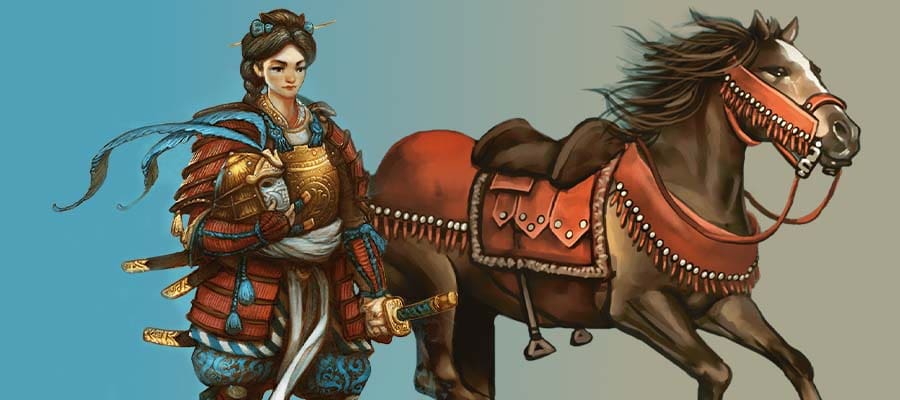
A warhorse is an animal in the 5e D&D world that is much like the warhorse that existed in our world during the middle ages. In 5e, it could be encountered as a monster or as a mount for a player character or NPC.
Who Can Use a Warhorse?
A warhorse can be used to travel by any player character that is not too large for the horse, and no Player’s Handbook (PHB) races are too large.
Warhorse vs Riding Horse

A riding horse can also serve as transport. Riding horses, however, are not trained for combat or special maneuvers. Any Animal Handling checks with them would be at a higher level of difficulty.
Even if no maneuvers are attempted, riding horses are more likely to get spooked by dangerous situations and require an Animal Handling check to keep the rider mounted. Here are the stats for both animals:
Riding Horse
| AC | HD | HP | Speed | STR | DEX | CON | INT | WIS | CHA |
| 10 | 2d10+2 | 13 | 60 ft. | 16 (+3) | 10 (+0) | 12 (+1) | 2 (-4) | 11 (+0) | 7 (-2) |
Hoof Attack: +5 to hit, Damage 2d4 +3 bludgeoning (8)
Warhorse
| AC | HD | HP | Speed | STR | DEX | CON | INT | WIS | CHA |
| 11 | 3d10+3 | 19 | 60 ft. | 18 (+4) | 12 (+1) | 13 (+1) | 2 (-4) | 12 (+1) | 7 (-2) |
Hoof Attack: +6 to hit, Damage 2d6 +4 bludgeoning (11)
Trampling Charge: If the warhorse has 20 feet of space to charge and scores a successful hit with a Hoof Attack, the victim has to pass a DC Strength saving throw or be knocked prone. The warhorse can make a Hoof Attack as a bonus action against a prone victim.
Mounted Combatant Feat
Mounted Combatant is a feat available to characters 4th level and above. I give a thorough explanation of this feat and 5e mounted combat in general in my article Mounted Combat 5e Guide.
My personal opinion is that feats are expensive and that proficiencies tend to be more practical. For using a warhorse, I certainly believe the Animal Handling proficiency will give you a better return on investment than the Mounted Combatant feat.
Animal Handling
Animal Handling is a proficiency based on Wisdom. As per PHB, it’s available as a skills proficiency for the following classes:
As per PHB, you can also acquire Animal Handling proficiency by choosing the right background:
- Folk Hero
Paladins and Animal Handling
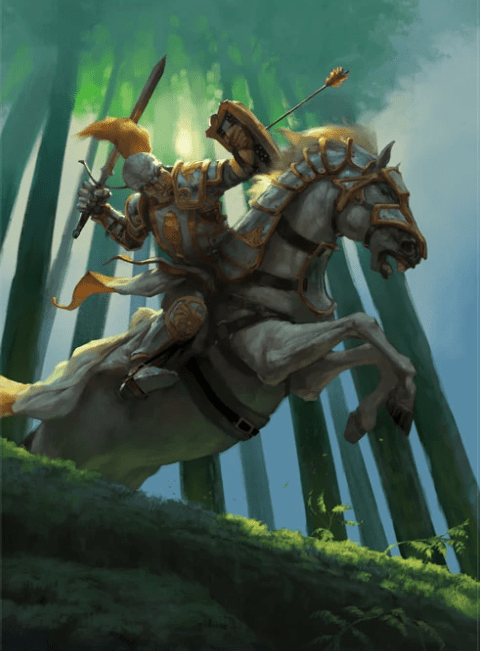
In 1e, paladins had a special affinity for warhorses. So much so, that they were granted an intelligent, hit-point-maxed-out warhorse upon reaching 4th level. In later editions, paladins gained all of the benefits of the prestige class, chevalier.
As later variants emerged, any character could also choose Riding as proficiency and improve their capabilities in D&D mounted combat.
You can imagine my surprise when paladins were not included in the Animal Handling list above when I wanted to generate my own 5e paladin. Paladins are basically knights, right? If they aren’t great on horses, who is? Who’s more likely to use a lance on a horse, a barbarian, a ranger, or a paladin?
Here’s how I would solve the problem with my DM.
Peregrine the Half-Elf Paladin
So, I’d like to create a male, half-elf paladin named Peregrine.
If we go outside of PHB rules and include all of the appendages (Tasha’s Cauldron of Everything, Xanathar’s Guide to Everything, etc.), the conversation about rules for character generation would be a very long one. Within PHB rules, however, I feel that the half-elves have the best builds for paladins and all of the other Charisma classes:
- Bards
- Sorcerers
- Warlocks
At least they are the best builds if your focus is on the ASIs (Ability Score Increases). Other PHB races with Charisma ASIs include:
- Drow
- Tieflings
- Lightfoot halflings
- Humans
- Dragonborn
If I want ASIs for Strength as well as Charisma, these are my PHB options:
- Half-Elves
- Humans
- Dragonborn
When building my character, I don’t like odd ability scores at the end of my calculations, 13, 15, etc. The reason is that a 13 is no better than a 12 and a 15 is no better than a 14. Those are just wasted ability points to me! A standard array has 2 odd numbers:13 and a 15. That means that I need two 1s from my ASIs to even out my 13 and 15. Goodbye, dragonborn! That leaves humans and half-elves.
The problem with humans is that their ASIs are 6 1s. They’ll even out my 13 and 15, but they’ll odd out my other 4 abilities. Therefore, half-elves are the best PHB race for Charisma classes.
Using the standard array (15,14,13,12,10,8), here are Peregrine’s stats:
| Ability | Strength | Dexterity | Constitution | Intelligence | Wisdom | Charisma |
| Standard Array | 15 | 14 | 13 | 12 | 10 | 8 |
| Assigned Stats | 15 | 10 | 12 | 8 | 13 | 14 |
| Racial ASI | +1 | +1 | +2 | |||
| Ability Scores Total | 16 | 10 | 12 | 8 | 14 | 16 |
| Ability Modifiers | +3 | +0 | +1 | -1 | +2 | +3 |
As a first-level character, Peregrine will get a +4 modifier, due to his Wisdom, if he gets Animal proficiency.
As a paladin, the skills proficiencies he has access to include the following:
- Athletics
- Insight
- Intimidation
- Medicine
- Persuasion
- Religion
If Peregrine wants to choose it from a character background. Folk Hero is the only background that has Animal Handling.
If Peregrine chooses Folk Hero, he will gain the following skills proficiencies with the following modifiers for 1st level proficiency and ability score combined:
- Animal Handling +4 (Wisdom)
- Survival +4 (Wisdom)
He will also get the following tools proficiencies:
- Artisan (Armorer)
- Land vehicle (Chariot)
Artisan and Land Vehicle are very general, so if I have to be specific, I would make the choices that I’ve placed in parenthesis above.
So far, I’m ok with these proficiencies because they’re useful and the other things I want, like Athletics and Persuasion, I can choose from my class.
For players who don’t want to choose Folk Hero, however, you can customize your background as per PHB p. 125:
- 2 skills proficiencies
- 2 tools proficiencies or languages
I can also switch around with other backgrounds. Let’s say I want to choose noble because my paladin is basically a knight:
- Persuasion +5 (Charisma) [keep]
- History +1 (Intelligence) [switch for Animal Handling +4 (Wisdom)
- Gaming +1 (Intelligence) [switch for Artisan Armorer Smith +5 (Strength)]
It makes no sense for my paladin to choose History and Gaming if I’m using Intelligence as a dump stat.
The point is that if you like using a warhorse in 5e, your character should obtain Animal Handling proficiency. Provided that you are creative, that shouldn’t be a problem regardless of your class.
Price, Capacity, and Barding
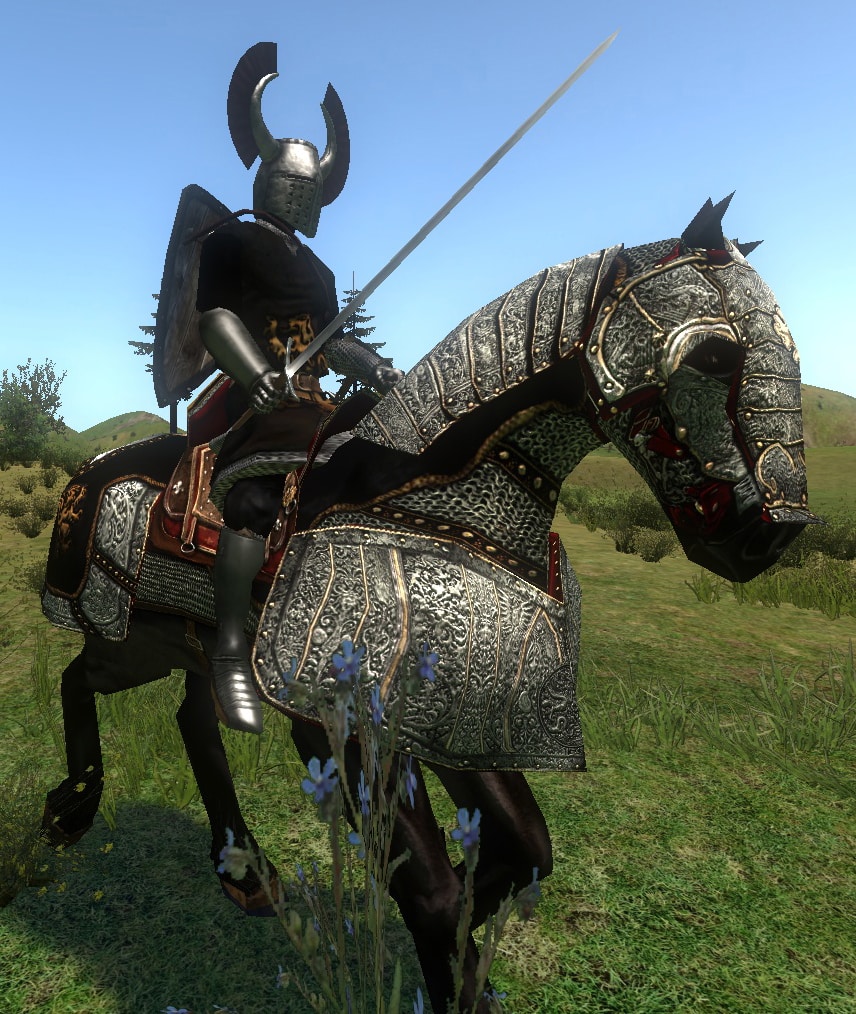
A typical warhorse equal to the one depicted in the stats section would be able to carry 540 lbs. and cost 400 gp. Some warhorses of lower quality might be cheaper, while others of better quality would be more expensive, possibly way more expensive. At the DMs discretion, warhorses with less carrying capacity and/or hit points might be available at a discount.
It is also assumed that horses with more carrying capacity and hit points, as well as higher ability scores, also exist. Naturally, these horses would be sought after and even if the players are willing to pay extravagant prices, there may be competition from other buyers.
The general rule for barding (horse armor) is that it is 4x the cost and 2x the weight. Below is my table for easy reference:
| Barding Type | Armor Class | Cost | Weight | Remaining Capacity |
| Plate | 18 | 6,000 gp | 130 lbs. | 410 lbs. |
| Splint | 17 | 800 gp | 120 lbs. | 420 lbs. |
| Chain | 16 | 300 gp | 110 lbs. | 430 lbs. |
| Scale | 15 | 200 gp | 90 lbs. | 450 lbs. |
| Ring | 14 | 120 gp | 80 lbs. | 460 lbs. |
| Studded Leather | 13 | 180 gp | 26 lbs. | 516 lbs. |
| Leather | 12 | 80 gp | 16 lbs. | 524 lbs. |
Once your character has the funds for a warhorse and barding, you need to calculate the weight your character and his or her equipment will bring and deduct it from the horse’s carrying capacity. Example:
At 1st level, Peregrine shows up at the stable with 15 gp in his pocket and is told to come back when he levels up.
At 2nd level, a few weeks and several dead goblins later, Peregrine triumphantly returns with 300 gp.
It’s not quite enough for a warhorse, but Peregrine uses his 16 Charisma and Persuasion +5 to work out some kind of deal because he has access to a lot of low-quality weapons and armor the goblins will no longer be using.
There is nothing left for barding, however. The horse’s armor class (AC) is 11. Because Peregrine has an Intelligence of 8, he gives his warhorse, a grey stallion, the creative name Horsey.
Peregrine is big for a half-elf due to his high Strength and average Dexterity. If he had both a high Strength and high Dexterity, he would be considered strong for his size, and thus, smaller and lighter. Therefore, Peregrine weighs 200 lbs. Horsey’s capacity 540 lbs. – 200 lbs., = 340 lbs. remaining capacity
Peregrine’s armor is chain mail (55 lbs.) and a shield (6 lbs.) for 61 lbs. total. 340- 61 = 279 lbs.
Peregrine’s weapons include:
- Lance- 6 lbs.
- Longsword- 3 lbs.
- Warhammer- 2 lbs.
- 5 javelins- 2 x 5 = 10 lbs.
- 2 daggers- 1 x 2 = 2 lbs.
Weapons weight total: 6 + 3 + 2 + 10 + 2 = 23 lbs. 279 – 23 = 256 lbs. remaining capacity
So, at this point in Peregrine’s adventuring career, Horsey has 256 lbs. remaining capacity for equipment and or/treasure that the paladin finds. If Horsey has to take on an additional passenger, 150-200 lbs., not including armor, weapons, etc., there will not be much additional capacity left over. This is without barding.
At 3rd level, Peregrine bounces back in with 100 gp. The price for chain mail barding is 110 gp, but Peregrine uses his Persuasion +5 to talk down the price to 100 gp. Horsey’s AC changes from 11 to 16. Peregrine’s weapons and armor are basically the same as before, so it is only necessary to deduct Horsey’s new barding from his carrying capacity: 256 – 110 = 146 lbs.
At 4th level, Peregrine can’t yet afford to upgrade Horsey’s barding but he can afford to upgrade his own armor. Peregrine sells his old chain mail and adds that to his additional funds to purchase some plate armor at a Persuasion +5 discount. The player must subtract the weight of the chain mail from the weight of the plate and subtract that difference from the remaining capacity. 65 – 55 + 10 lbs. 146 – 10 = 135 lbs. Not much difference.
Peregrine gleefully continues on his overland adventures but has to hire a stable for Horsey when the paladin explores dungeons.
At 5th level, Peregrine can finally max out his warhorse with plate barding! Of course, by then, Peregrine has access to Find Steed spell and can simply magically summon a warhorse. If he were to do that, he could sell Horsey at a Persuasion +5 price and keep his new Find Steed warhorse instead. But Peregrine is a sentimental lug of a paladin and he just can’t bring himself to part with the warhorse who has faithfully served him through 3 levels.
With the new plate barding, Horsey’s AC moves from 16 to 18. Using the formula for Peregrine’s own armor upgrade above, the player calculates Horsey’s new carrying capacity. 130 – 110 = 20. 135 lbs. -20 = 110 lbs. Horsey probably won’t be taking any additional adult passengers at this point unless they have no armors, weapons, or equipment. Regardless, 110 lbs. extra capacity for treasure, equipment, etc. is not bad considering that both Horsey and Peregrine are wearing full plate armor.
Warhorses and Dungeons
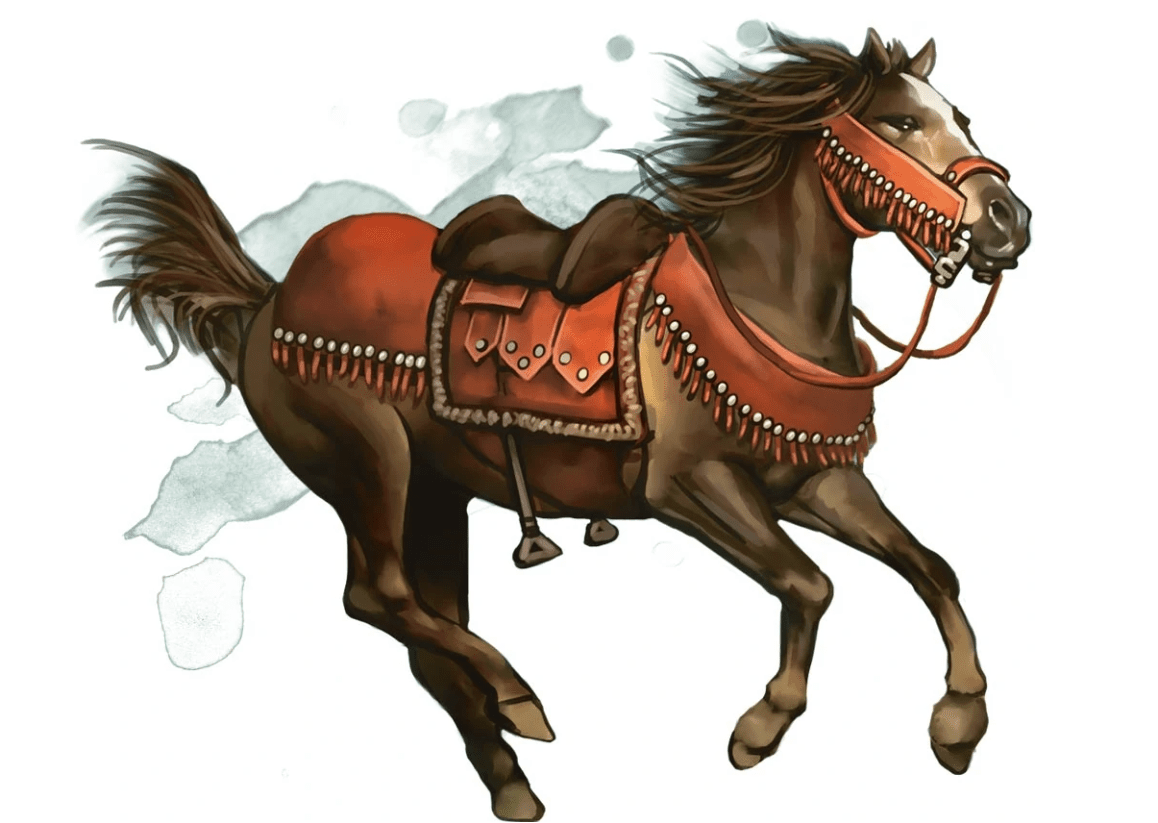
As a rule of thumb, warhorses are for overland adventures only, not dungeons. Taking a warhorse or any horse, mule, camel, etc. into any dungeon would be considered an act of animal cruelty and would be considered unacceptable for good-aligned characters, as well as druids and Oath of Vengeance paladins. Obviously, with pack lizards, riding lizards, and other Underdark mounts, there is no ethical issue since these mounts are comfortable underground.
Exceptions would be save-the-world missions and taking the warhorse into a dungeon for the safety of the horse, i.e., a dangerous storm is about to hit or a tribe of marauding orcs is approaching. Even in such exigent circumstances, as a DM, I would require an Animal Handling check. The Animal Handling check table below is my homebrew:
| Circumstance | Warhorse | Mule | Other (riding horse, camel, elephant, etc.) | Frequency of Animal Handling check |
| Hanging out just past the threshold | DC 10 | DC 5 | DC 15 | 1/day |
| Advancing into the dungeon | DC 15 | DC 10 | DC 20 | 1/day |
| Going below the first level | DC 20 | DC 15 | DC 25 | 1/day and/or 1/level descent |
Example: Peregrine needs Horsey for a save-the-world mission to prevent an evil lich from unleashing an Ancient One and massacring hundreds of thousands of innocent people.
- DC 10 entering the dungeon
- DC 15 exploring the first level
- DC 20 descending down some stairs to the second level
- DC 15 exploring the second level
- DC 20 descending down to the third level
If Percy fails any of these Animal Handling checks, Horsey will Dash out of the dungeon and, once outside the dungeon, Dash for higher ground. If Peregrine or any of his companions attempt to restrain Horsey after a failed Animal Handling check, Horsey will make hoof and trampling attacks.
Warhorse Applications

Any rider on any trained mount in addition to basic movement can direct the mount to take 3 actions:
- Dash
- Dodge
- Disengage
As per PHB p. 198, that’s all a directed mount can do. Independent mounts can fight.
Warhorses, however, are trained both to serve as mounts and to participate in combat. History in the real world has plenty of examples of warhorses being directed to attack with their hooves and/or trample. PHB p. 178 states in the Animal Handling section,
“You can also make a Wisdom (Animal Handling) check to control your mount when you attempt a risky maneuver.”
Directing an animal that has been preselected and trained for war to kick with hooves wouldn’t even qualify as a risky maneuver. For strict DMs, I would suggest a DC easy Animal Handling check. For lenient DMs, I would say that directing a warhorse to kick and/or trample is not even a maneuver but could be added to Dash/Dodge/Disengage because the mount in question is a warhorse. For domesticated but non-combatant mounts, like mules and riding horses, it would not be as easy. Example:
Peregrine, at 3rd level, finds himself and Horsey in the middle of a battle. There is an enemy soldier 100 feet away that has to be taken down. Peregrine’s player Fred tells the DM, “I direct Horsey to Dash while I attack with my lance and direct Horsey to attack with his hooves. If Horsey hits the soldier and successfully knocks him down, I want him to trample the soldier.”
The male soldier gets to attack first because he has a ranged weapon. Because Peregrine is a 3rd level character at this time, he has been able to afford chain mail barding for Horsey. Horsey’s AC is 16 while Peregrine’s is 18.
The soldier fires his crossbow bolt and misses.
The DM rules that both the 100-foot Dash and Peregrine’s attack fall within the same turn because Peregrine can fight while his mount is running and Horsey’s speed of 60 feet/turn can be up to 120 feet when doubled with Dash.
Fred scores a hit with his lance and does 9 damage. The soldier has 18 HP and is now down to 9.
The DM decides to be strict about Horsey’s attack, especially during a Dash. Fred has to pass a DC 10 Animal Handling check. Since Peregrine’s Animal Handling modifier is +4, Fred needs to roll a 6 or higher. Fred passes the check.
The soldier has an AC of 16, chain mail with no shield. A very strict DM would insist on rolling for Horsey, but this DM lets Fred roll. Horsey, as a warhorse, has +6 to attack rolls with his hooves. (That’s better than Peregrine at 3rd level). Fred needs a 10 or better to hit the soldier and does so. Fred chooses not to roll for damage and accepts Horsey’s default damage of 10 points. (2d6 +4 bludgeoning)
The soldier’s 9 HP are reduced to -1. The soldier is effectively dead now but gets trampled anyway, suffering another 10 HP deduction. At the end of round 1, the dead soldier is at -11 HP. Through proper use of a warhorse, Fred was able to effectively grant his 3rd level character 3 attacks in 1 turn!
Lance
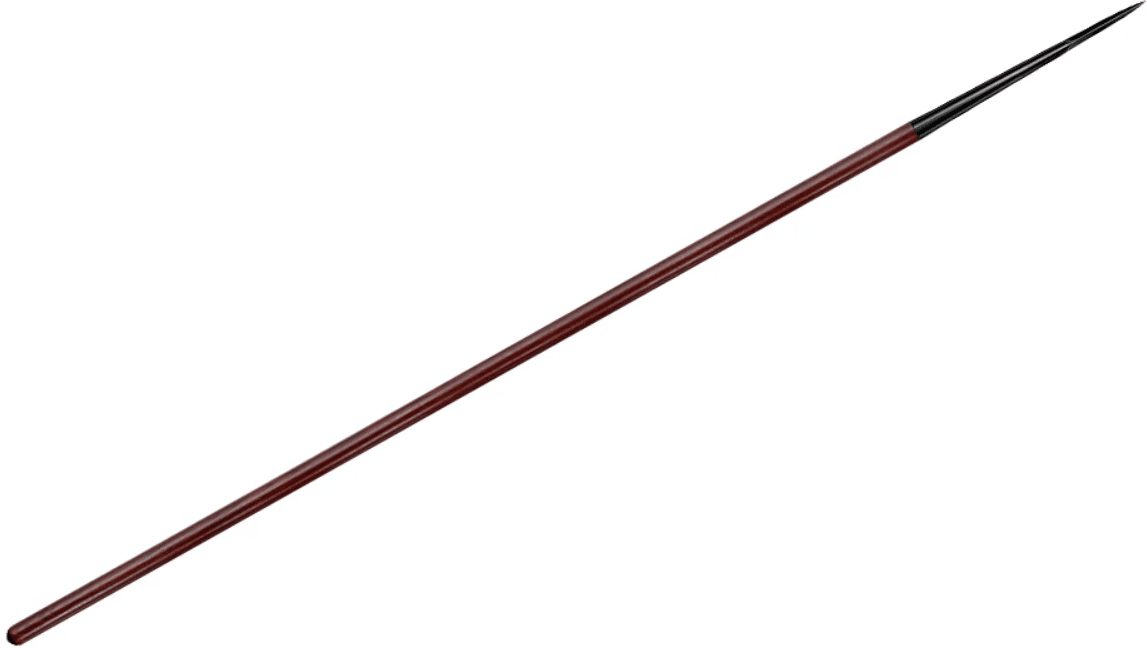
The lance is a reach weapon specifically designed for mounted combat. Like all reach weapons, it allows its user to attack from one hex, 5 feet, away. It does more damage than other reach weapons, however, 1d12, and, unlike the others, the user can employ a shield simultaneously.
The drawback of this weapon is that when an opponent enters your hex, 5 feet, your attacks against that opponent are at a disadvantage.
Making a Pass
I referred to Making a Pass in my Mounted Combat Guide 5e. Making a Pass is when you charge your opponent on a parallel line. Your intention is to never enter your opponent’s hex, but rather to make an attack in passing. This can be done with a lance or any reach weapon that can be used while riding a horse:
- Halberd
- Glaive
- Pike
A warhorse has a speed of 60 feet/turn. If your opponent doesn’t have equal or better speed, he or she can’t stop you from passing on a parallel line and cannot enter your hex before you continue to ride past. Without a reach weapon or reach-ability, your opponent cannot make a melee attack. Example:
Peregrine uses his Survival +4 proficiency to spot a hungry, wounded brown bear. Peregrine loves cute teddy bears as much as the next paladin, but there’s a human settlement nearby. He knows that the bear has to be put down.
Peregrine’s player Fred announces to the DM, “I’m going to use Horsey and my lance to make a pass.”
There is no point in rolling for the initiative because the lance is a reach weapon and the bear doesn’t have enough reach to attack outside its own hex.
Peregrine scores a hit with his lance. Rather than roll for damage, Fred chooses to just accept the base damage of 6. Peregrine’s damage modifier is +3 so the total is 9 damage points.
The bear swipes at the air with its claws and snaps away with its jaws, but Peregrine and Horsey are not in the bear’s hex. The bear dashes but Peregrine was expecting this, so he directs Horsey to dash too. (Before rolling the dice, Fred had expressly stated, “As we attack, I’m watching the bear. If the bear starts to dash, I’ll change my pass into a dash after my lance’s attack.”)
The bear has a speed of 40 feet/turn, so its dash is 80 feet for that turn. Horsey has a speed of 60 feet per turn, so his dash is 120 feet/turn.
At the end of the round, the bear has 21 remaining hit points. The bear normally would have 34 hit points (HP), but the bear had been wounded before its encounter with Peregrine and Horsey, so it was down to 30 HP before the fight even began. The first round of combat took the bear from 30 to 21 HP.
As a lawful good paladin, Peregrine doesn’t like any of this. Unfortunately, this wounded and hungry bear is a threat to local peasants and their livestock. Sadly, Fred announces to the DM,
“I make another pass, taking the same precautions in case the bear makes another dash.”
Whether it takes Peregrine 3 rounds or 10 rounds, this bear is doomed unless the paladin’s lance somehow breaks. As a 2nd level character, Peregrine only has 18 hit points, much less than the bear at the start of the encounter. At this point in his career, he couldn’t afford any barding for Horsey, so his AC is 11. Had it not been for this Making a Pass application, this fight could have been very dangerous for both the horse and its rider.
Obviously, if your opponent has a reach weapon and/or a ranged weapon, making a pass won’t protect you from attacks. Also, if the opponent is at an equal or greater speed than your warhorse, the opponent can enter your hex past your lance’s reach and attack.
Thundersmite
One of the reasons why paladins are cool is that a lot of their spells count as bonus actions, rather than actions. That’s great for players that have a high action economy style of play. The 1st level paladin spell Thundersmite is perfect for being used in conjunction with a lance and warhorse. Example:
Peregrine is 3rd level at the time of this battle and has access to Thunderstrike Spell. He sees his opponent Slinky Underhill, a chaotic evil 5th-level halfling rogue assassin brandishing 2 shortswords, and wins the initiative roll. Fred announces, “I cast Thunderstrike Spell as bonus action at the beginning of my turn. Then I direct Horsey to Dash and make a hoof attack and a trampling attack on the halfling.”
Fred passes the Animal Handling check and is successful with all attacks and Slinky (Strength 8) fails his Strength check and is knocked prone for trampling. The damage is as follows:
- Thunderous Smite: 6
- Lance: 9
- Hoof: 10
- Hoof: 10
- Total: 35
Slinky has 43 HP but has Uncanny Dodge. So, instead of deducting 35 points of damage, 18 points are deducted, leaving the Slinky at 25 HP.
For his action, Slinky has time to switch to his shortbow and fire one arrow at Peregrine, hitting him for 7 points of damage.
Since there are no additional enemies within 5 feet of Peregrine and Horsey, there is no Sneak Attack. Peregrine at 3rd level has 25 HP, so he is now down to 18 HP.
Ranged

In real-life history, the mounted archer had a real advantage on the battlefield. Mongols, Huns, etc., were able to fire their arrows at infantry positions, only to move out of range when the infantry tried to counterattack.
In gaming terms, you can apply the use of speed and range in the same way that the lancer applies speed and reach as stated above. Example:
Moonwhishper is a 5th-level female wood elf ranger with an 18 Dexterity. She is riding a warhorse and is armed with a longbow and 2 scimitars. She spies a large patrol of 50 goblins, all armed with short bows and scimitars, and decides to exterminate them.
The goblins move at 30 feet/turn. A warhorse moves at 60 feet per turn. Moonwhisper has speed over the goblins. She can fire at them all day long and they won’t catch her.
With range it’s more complicated. The maximum long range for a longbow is 600 feet and the maximum range for a shortbow is 320 feet. Moonwhisper has a long-range advantage. However, the maximum short range for a longbow is 150 feet, still within the 320-feet long range of the goblins’ shortbows. If Moonwhsiper tries to fire her longbow from short range, the goblins can still hit her by firing from long range, albeit by attacking at a disadvantage.
If Moonwhisper wants to be completely safe, she’d have to fire from long range and attack at a disadvantage herself. She will probably need more than one shot per kill. That means that unless she has over 100 arrows in her saddlebags, she’ll probably run out of arrows before she runs out of goblins!
However, if Moonwhisper has planned this massacre in advance, she could be holding more than 1,000 arrows in her saddlebags. As per PHB p. 150, each quiver, I’m assuming fully loaded, weighs 1 lb. Each quiver contains 20 arrows, so Moonwhisper would need 50 quivers to store 1,000 arrows. Adding 50 lbs. to a warhorse with a carrying capacity of 520 lbs. is not a problem.
FAQs
Question: Does a warhorse get a Dexterity bonus for armor?
Answer: Yes, for light and medium armor and that was factored into the barding table.
Question: Does directing your mount cost you an action or a bonus action?
Answer: Directing your mount is part of your horse’s movement and should cost you neither an action nor a bonus action.
Therefore, Peregrine, during his battle with Slinky, was able to direct to perform an action, direct Horsey to do the horse’s actions, and perform his own actions all in 1 turn resulting in a total of 4 attacks.
Conclusion
In a game where action economy can mean the difference between life and death, I hope my article has shown players the benefits of proper warhorse utilization and the utility of Animal Handling proficiency. In a fantasy world where griffons and dragons can serve as mounts, I find that bringing a real-world mount into the game adds a more realistic flavor.
This is the debut of Peregrine and Horsey but if you liked Slinky, there are more details about his character in my upcoming article Uncanny Dodge 5e Guide. Moonswhisper’s character creation is in my Mage Slayer 5e Guide: Is It Worth It?.
- Perform Bewitching 5e Guide - October 1, 2022
- Inspiring Leader 5e Guide - September 20, 2022
- Scrying 5e Guide - September 19, 2022

